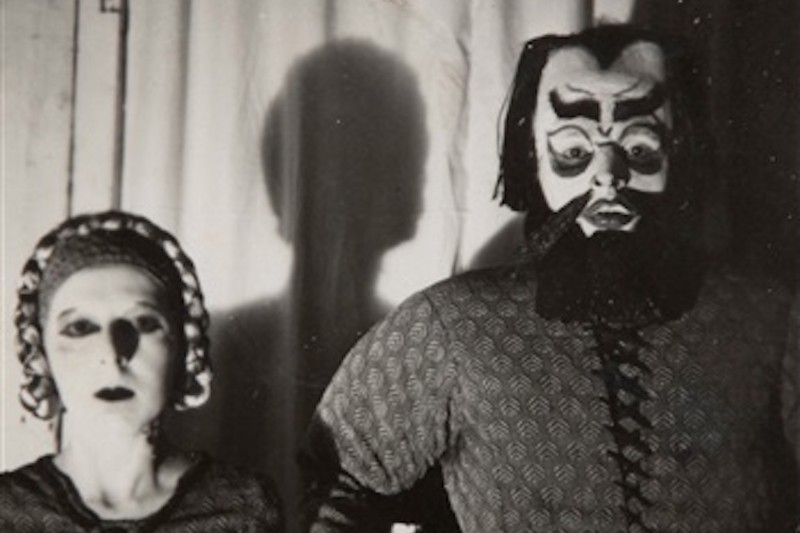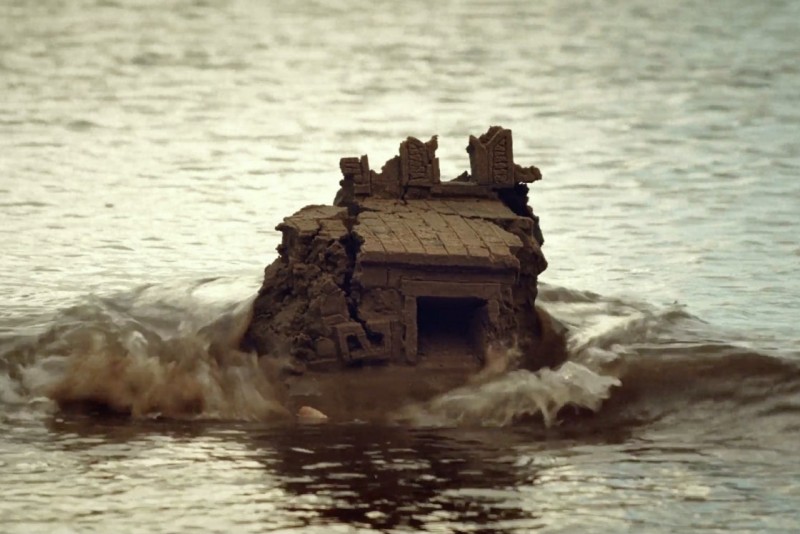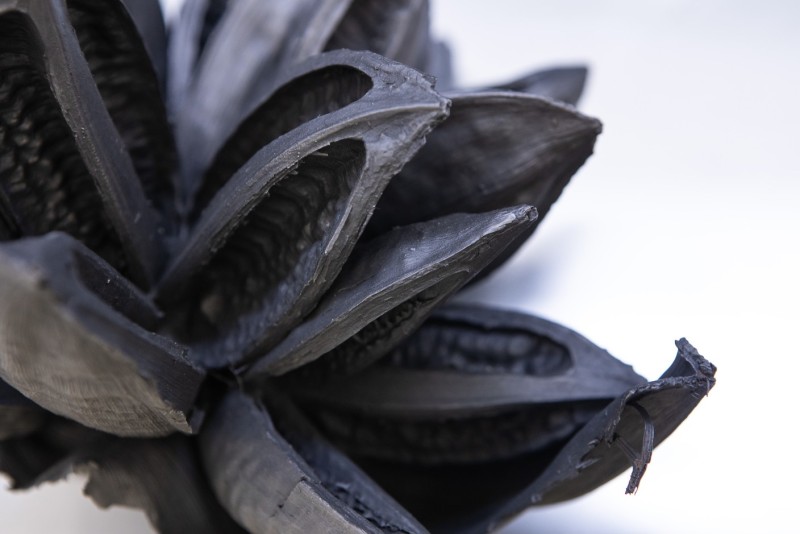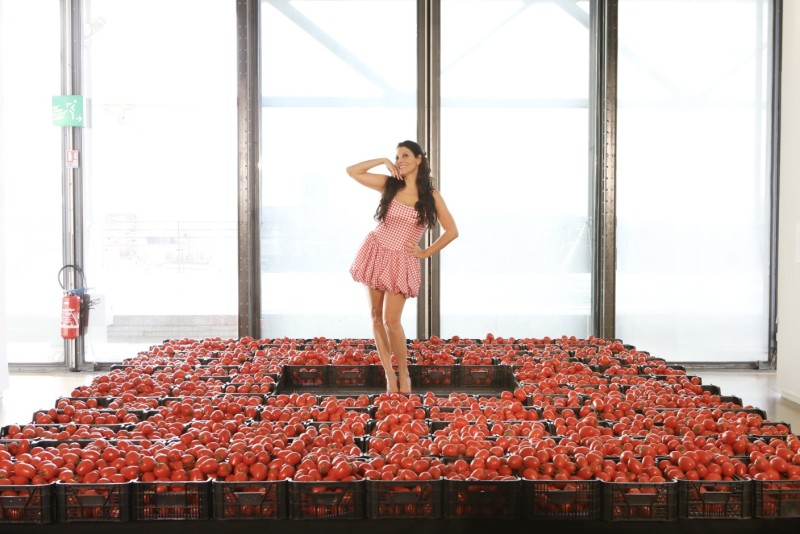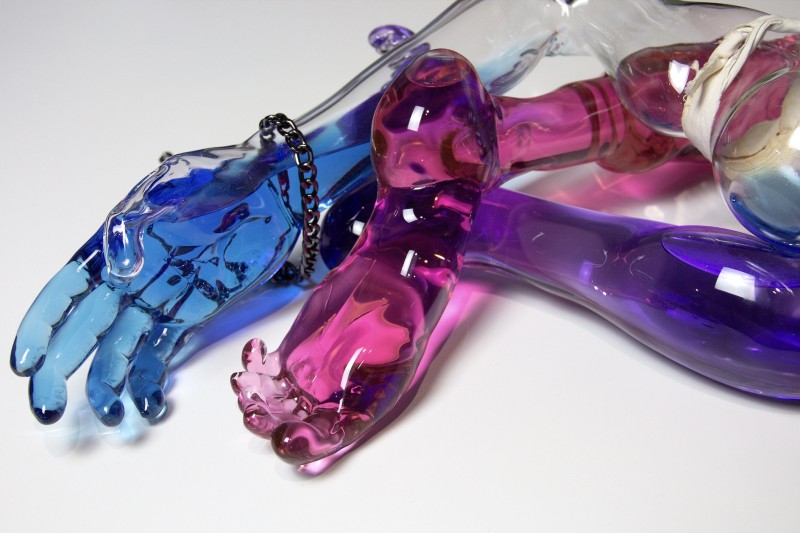Nantes, FR, 1894 - Saint Helier, Jersey Island, UK, 1954
Claude Cahun was a Surrealist artist who, together with their half-sibling and life partner Marcel Moore, anticipated discussions on topics of extreme relevance in contemporary society, such as gender and identity. In their practice they used a variety of media: photography, writing, collage, sculpture, disguise, transformation, performance and theatre.
The majority of their works are part of the collections of the Musée d'arts de Nantes (France) and of the Jersey Heritage (UK).
Born in 1988 in France. Lives and works in Paris.
Marielle Chabal devotes her work as an artist, researcher, and director to the construction of speculative fiction, more or less 'science-fiction', to question viewers about the world around them. With her regular or variable collaborators, the form of speculative fiction enables her to detect, from bricks of possibility, the fears aroused by the evolution of our societies. Her work takes the form of performative mood boards, symposiums, talk groups, films, and installations, always in formal alignment with the essence of the project. The obsessive nature of the collaborative form at the heart of her practice is reflected in her projects, as is the desire to come together to twist the world and realities through the prism of thinking about a shared future. Her works, driven by a collective and 'elastic' energy, are devices for re-apprehending and influencing the realities that overwhelm us and fictionalizing the real, in line with her vision of a re-evaluation of the social and political role of art.

Born in 1973 in Edinburgh, UK. Lives and works in London, UK.
Gayle Chong Kwan is a London-based artist, whose large-scale photographic installation, sound, participatory, and video work is exhibited nationally and internationally, both in major institutions and in the public space.
Her work is an ongoing investigation into simulacra and the sublime, which she explores through constructed immersive environments and mises-en-scène. The personal and global politics of food and tourism is a major focus of her practice that is often specific to a context and linked to the exploration of histories, memory and senses. The artist's pieces take the viewer on a journey across countries and civilizations, exploring the relationship between food and culture, and underlying the importance of waste in giving measure to our lives.
Born in 1972 in Ardèche, France. Lives and works in Paris, France.
The practice of Marie Denis focuses first and foremost on an object and how it may potentially be reinvented. Marie Denis' work is also concerned with botanical principles. Her installations and sculptures are designed from raw materials and other objects diverted from their typical anchors in culture.
She likes to circumvent the rules to realize her work, which is often sculptural: a vegetable path that "kaleidoscopes" the idea of nature, its beauty and fragility.
Born in 1982 in Naples, Italy. Lives and works in Paris.
Romina De Novellis is a performer, visual artist and anthropologist, born in Naples and grown up in Rome, active in Paris since 2008.
After several years dedicated to dance and theater, Romina De Novellis has approached performing arts, studying the body both from an anthropological viewpoint and from the perspective of Mediterranean cultures.
The artist uses ecofeminist theories as a parameter to analyze and denounce the oppressive realities of our societies, as well as the dichotomies nature-humanity, femininity-masculinity, North-South, scientific-intuitive, power-bodies and establishment-cultures. Traces of her performances are collected in form of polaroids, photos and videos.
Born in 1975 in Rijeka, Croatia. Lives and works in Rijeka, Croatia.
"Igor Eškinja constructs his architectonics of perception as ensembles of modesty and elegance. The artist ‘performs’ the objects and situations, catching them in their intimate and silent transition from two-dimensional to three-dimensional formal appearance. Using simple, inexpensive materials, such as adhesive tape or electric cables and unraveling them with extreme precision and mathematical exactitude within strict spatial parameters, Eškinja defines another quality that goes beyond physical aspects and enters the registers of the imaginative and the imperceptible. The simplicity of form is an aesthetic quality that opens up a possibility for manipulating a meaning. It derives, as the artist states, from the need for one form to contain various meanings and levels of reading within itself. The tension between multiplicity and void constitutes one of the most important aspects of Eškinja’s mural ‘drawings’ and seemingly installations. A void is still an active space of perception; it does not conceal; it comments on the regime of visibility, it invites the viewer to participate in the construction of an imaginary volume in an open space. The temporary nature of the artist’s spatial structures and the ephemeral quality of his carpets (where ornaments are carefully woven out of dust) manifest a resistance to the dominant narratives of institutional apparatus and socio-political order." - Extract from a text by curator Adam Budak

Born in 1983 in Trento, Italy. Lives and works in Trento (Italy).
His theoretical and field research unfolds in archival and museum contexts, from which he draws inspiration with the aim of enhancing little-known heritage. His practice develops at the intersection of visual art and scientific disciplines, investigating how the latter have used the artistic medium to progress. Through historical and archival research, he attempts to deconstruct the binary condition that separates deviance and normality, reflecting on the normative attributions of disease, marginalization, and categorization in contemporary society.
By using different forms of expression, from installation to photography, from sculpture to video, Fogarolli’s works stimulate critical thinking on the relationship between mind and brain, reflecting on how the functional processes of the latter interact with the subjective ones of the mind, and investigating how these acts of thought develop into behaviors considered lawful or prohibited.
Born in 1978 In Portugal. Lives and works between Paris and Luxembourg.
Marco Godinho's approach leads him, with a certain economy of means, to use various media as active environments, installations, performative gestures, videos, sound pieces, drawings, sculptures, photographs as well as his writings, collaborative works, typographic compositions, artist books and scenography. Influenced by literature, poetry, philosophy, and nourished by a life punctuated by continuous displacements marked by diversity—whether social or cultural—Marco Godinho’s work offers a reflection on questions of exile, hospitality, geography, immigration, and is often the result of encounters with the living, between everyday objects and language elements. As he likes to define himself, a «nomadic traveler», he outlines the contours of a map of a world shaped by personal, biographical, and multicultural trajectories, intended to question us about our perception of the space and time in which we live.
Born in 1975 in Buenos Aires, Argentina. Lives and works in Buenos Aires, Argentina.
Luciana Lamothe works with sculpture, drawing, installation, photography and video, using architecture as a tool to show social values subjected to the rigidity of vertical structures where control, patriarchal hegemony and strongly established cultural models predominate and influence the idea of gender. Lamothe creates artworks that challenge these preconceptions and asks the viewers to establish a relation with their own bodies, the exhibition space and the materials of the works. The sculptures often trigger instability and vertigo as a metaphor of the fragility of socially established structures. The brutalist and minimal aesthetics of the sculptures, installations and drawings often contrast with the extremely fine and delicate forms of the works.
The artist has recently represented Argentina at the 60th Venice Biennale Arte 2024 'Foreigners Everywhere' with the project 'Ojalá se derrumben las puertas', curated by Sofía Dourron.
Born in 1984 in Saint Junien, France. Lives and works in Paris, France.
Marie Lelouche is a French artist, whose practice deals with different forms of spatiality.
Graduated from ENSBA in Paris, obtained a Master's degree in Visual Arts at La Sorbonne (Paris), and completed a program at Le Fresnoy with distinction and congratulations from the jury. In April 2025, she achieved her PhD in post digital sculpture at Le Fresnoy (Tourcoing, France) in collaboration with UQAM (Montreal, Canada).
Interested in the evolution of forms in their technical and cultural context, with a focus on remix practices and the perceptive possibilities offered by Extended Reality (XR), Marie Lelouche won the DICRéAM, the Pictanovo Interactive Experience Fund, received a special mention for the Adagp Revelation Digital Art Prize, and was a finalist for the Opline Prize and Siemens Ingenious Prize.
Born in 1964 in London, UK. Lives and works in Los Angeles, USA.
Marcos Lutyens’ artistic practice targets the psychic and emotional well-being of his audiences by skillfully leading participants in hypnotic exercises that affect the deepest levels of their psyche. His works take form in installations, sculptures, drawings, short films, writings and performances.
In his explorations of consciousness, Lutyens has collaborated with celebrated neuro-scientists V. Ramachandran and Richard Cytowic, as much as studying under shamans from different cultures. From these investigations and research he has worked with visitors’ unconscious states in museums, galleries and biennales around the world.
Born in 1975 in Sofia, Bulgaria. Lives and works in Sofia, Bulgaria.
Ivan Moudov is a multidisciplinary artist from Sofia, Bulgaria.
His artistic practice comprises photography, video, performance and installation. In his work the artist questions the field of contemporary art within the system of power, as well as the socio-political and economic conditions, providing a critical and corrosive analysis on political and social conventions, as well as questioning individual behaviour.
Deconstructing the usual chain reaction of actions and facts, judging and analyzing them in a playful way, Moudov underlines the ambiguity of the real and the inadequacy of the instruments of interpretation. Furthermore, by subverting the existing norms and rules of the contemporary world, he aims at revealing their functioning and at analyzing them critically.
Born in 1945 in Judenburg, Austria. Lives and works in Vienna.
Vienna-based artist Fritz Panzer’s use of lines is peculiar as it takes shape both on paper and in the space. Thanks to the wire, the brush and pencil signs on paper assume a three-dimensional nature, where airy and partially incomplete volumes are created and in front of which the viewers are asked to rely on their own memory in order to complete their meaning.
Since the 70s, the artist has realized sculptures starting from everyday objects on a scale of one to one, therefore the artworks are either a small shoe box, a chair, or an entire kitchen, occupying a considerable space. From drawing to wire sculptures Panzer’s lines thicken and gain substance, while creating very light objects that can be seen through by the viewer and where emptiness is essential: his works play between visible and invisible, conserving volume and density. A wire contour defines space and, at the same time, encloses it giving shape to forms with no materiality and no weight.
Familiar and everyday objects of different dimensions, such as a chair, a piano, a box, a carton of milk, a kitchen, a car, a shelf are Panzer’s favorite subjects. Very well known elements that offer everyone the possibility of a quick recognition and the enchantment of a completely new experience.

Born in 1964 in Venice, Italy. Lives and works in Venice, Italy.
Graduated from the Accademia delle Belle Arti of Venice in 1987, Michelangelo Penso has been exhibiting his works in various private galleries and public institutions. Specialized in sculpture, Penso works with various materials of industrial origin, mainly rubber, polyester belts, pieces of aluminium and steel to create three-dimentional installations: genetic expanded structures that fill the space they inhabit.
Born in 1989 in Cittadella (Padua), IT. Lives and works in Turin, IT.
Sgambaro's research explores existential issues related to the condition of generational precariousness. Using different media, ranging from installation to photography, from sculpture to audio, he gives life to caustic narratives as a response to contemporary disparities. Delving through generational imagination and adopting an irreverent attitude, the artist is interested in the activation of survival mechanisms as a way to imagine possible survival solutions. His research is in fact linked to generational problems, with an eye to contemporary hysterias and obsessions caused by the search for fame. His works are presented through the use of narrative paradoxes triggered by traces of ephemeral corporeality. The body is the intermediary of the provocative, ironic gesture, that, together with the posthumous trace, resists the catatonic state and modifies space and matter. The importance of physical interaction is therefore a key to understand the installations that often weave with site-specific and participatory practices.

Born in 1979 in Gorizia, Italy. Lives and works in Monfalcone, Italy.
“My works combine sound and visual arts with a thorough conceptual research and are defined by a transversal method and an essential aesthetic. The creative impulse comes as a reaction to the huge amount of data surrounding us. I subtract, isolate and rework the preexisting matter in search of a new semantic system. I try to stimulate the observer's engagement by subtly altering their perception. The silence, acoustic resonance and imperceptible sound variations in space and matter are the core of my sonic practice. I focus on fragments and marginal elements of architecture, recording the simple geometry of light, away from preset information and superstructures. I investigate the relationship between space and perception through photography, sculpture and sound”. - Michele Spanghero
The artistic activity of Michele Spanghero, who has both a Literature and musical background, ranges from the field of sound art, to sculpture and photography.
Born in 1974 in Schlanders, Italy. Lives and works in Vienna, Austria.
Esther Stocker's work consists mainly of paintings and installations in an abstract and geometrical perspective, the two genres being closely related to each other. The artist's installations are three dimensional projections of her paintings, exclusively made with a limited palette of black, grey and white. Could they be described as spatial, sculptural paintings or rather as pictorial spaces?
Her research focuses on vision and perception of space with a social and contemporary approach. The creation of her pieces is connected to a highly elaborated mathematical discourse, an essential part of her artistic method. The artist's reflection is focused on the question: "How is a perfect system actually imperfect?". Her geometric structures are based upon eternally self-repeating modules that create a seemingly ordered visual rhythm, to which she adds aberrations in order to generate an adjacent but new rhythm. This introduction of deviation in the optical balance creates surprise and emotion through the purposeful disruption of order and plane dimension.
"In my paintings, sculptures and installations I try to describe the ambiguity and uncertainty of the system. I use the precision of a system to investigate the system itself. I try to release and abandon our ways of seeing and understanding that are associated with the recognition of forms and that distinguish us from each other, sometimes unconsciously."

Born in 1973 in Beja, Portugal. Lives and works in Paris.
Graduated from Villa Arson, in Nice, João Vilhena practices drawing from a neo-conceptual position. His work is and has always been, led by the interest he takes in the role of the beholder. For the artist, a work is made by the look upon it, which activates it and creates its meaning. A virtuoso of the pencil and the word, João Vilhena feints, hides, substitutes, and disguises without ever unveiling what lies beyond. To this purpose, he uses different means like optical illusions, trompe l'oeils or anamorphoses, as well as works' titles spoonerisms, anagrams, and other word games.


